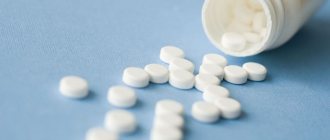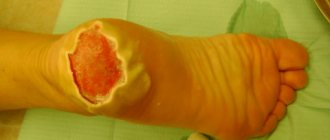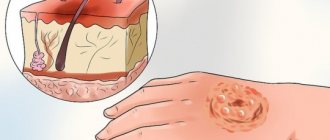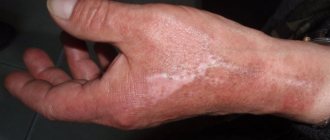Vinegar is one of the most necessary products in everyday life. Despite awareness of its dangers, lurking even in diluted essence (3-15%), burns are still common. The cause of these dangerous chemical lesions lies in the carelessness of adults, and in children the curiosity and negligence of parents become the culprit. To avoid serious consequences, you need to have an idea of how to treat a burn with acetic acid on the skin. Competent medical care provided immediately after injury minimizes damage to the skin, mucous membranes, and eyes.
Types and degrees of damage
Incorrect handling of an unsafe product causes vinegar burns. There are two types of such injuries:
- An external wound that affects the skin or mucous membranes. Prolonged contact with surfaces causes severe damage, so treatment depends only on the reaction speed of the victim and his loved ones. A strong concentration of vinegar (from 70%) causes severe damage, so it is necessary to urgently rid the area of the body from contact with acid. The extent of the wound is a reason to immediately consult a doctor.
- An internal burn caused by exposure of the larynx, esophagus or stomach to a chemical is infinitely more dangerous. If vinegar enters the stomach, it immediately begins to come into contact with hydrochloric acid found in the digestive juice. In this situation, urgent medical attention is required even in the case of low concentrations of the product. In case of internal defeat, it will not be possible to save yourself using folk remedies.
Internal or external skin burns with vinegar, like other types of similar injuries, have 4 degrees of severity. Not everyone will be able to correctly assess the condition, so the help of a doctor is necessary.
- The first is a mild burn. With it, hyperemia (redness), swelling of tissues, and painful sensations are observed. Unpleasant symptoms disappear after a few days (3-4), leaving a slight peeling that disappears without a trace. The skin heals completely, no defects remain.
- Second. Both layers of the epidermis are affected: the stratum corneum (outer) and the germ layer, in which cell regeneration occurs. Therefore, blisters with serous contents are added to the symptoms. This burn also goes away without consequences, but it takes one and a half to two weeks for complete healing.
- Third, fourth. They are characterized by a deep burn surface, since all layers of the skin are affected, including sweat and sebaceous glands, blood vessels (3rd degree), and fatty tissue (4th degree). A sign of this stage is the rapid formation of brown or black crusts and scabs. The cause is contact with high concentration vinegar.
In case of a chemical burn of the skin, composure is necessary: timely first aid and subsequent consultation with a doctor in severe cases minimize the risk of encountering dangerous complications.
Medicines
Only the doctor decides how to treat the burn depending on the degree of damage and the severity of the patient’s condition. Self-medication can lead to the formation of rough scars and adhesions.
Medicines used to treat chemical burns can be divided into groups:
- Disinfectants for aseptic treatment of wounds;
- Painkillers and anti-burn mixtures;
- Antibacterial agents that prevent the development of infection at the site of injury.
In mild stages (slight redness and burning), you can use Levomikol, Panthenol, Bepanten and other drugs of similar action.
Clinical picture and features of burns with acetic acid
The symptoms of acetic lesions vary and depend on its location, duration of contact, and area of the area. A vinegar burn on the skin immediately appears as a white spot, which turns gray after a short period of time. The victim feels a burning sensation and severe pain. Then a clearly defined crust forms on the surface.
It is known that the effect of acetic acid can be weakened or completely removed with alkali, so after washing the injury, it is necessary to treat the area with a soda solution.
If vinegar gets inside, dangerous signs appear:
- instant pain in the mouth, throat, stomach, swallowing causes it to intensify;
- difficulty speaking due to swelling of the lips and mouth;
- elevated temperature;
- nausea, vomiting, or excessive salivation;
- pain, swelling in the area of the lymph nodes.
When inhaling hot vinegar fumes, the first symptoms are a permanent cough, runny nose, watery eyes and difficulty breathing. Severe damage causes shock, shortness of breath, tachycardia, and acute toxic psychosis is possible.
Don't clean with vinegar!
Marble and granite kitchen countertops
© Jupiterimages/Photo Images
If the budget allows, many people line their homes with marble. This material is especially readily chosen for window sills and stairs. Well, kitchen countertops made of marble are the dream of every housewife.
It is important to understand here that marble, by and large, is a calcareous rock that was formed over several centuries. And if lime is destroyed by acid, it would be logical to assume that approximately the same thing happens with products made of marble and granite.
Vinegar is a very dangerous product that corrodes some natural materials, including marble and granite.
These two stones, due to their origin, do not tolerate the effects of vinegar. Moreover, regular use of vinegar causes corrosion of the material.
The safest and most effective way to clean a marble or granite countertop is with a mild soap solution that you can make yourself.
But it is best to avoid aggressive cleaning products that contain acetic acid.
Another important point: if you accidentally spill vinegar on a countertop made of natural material, try to quickly wash off the puddle with warm running water and then wipe it dry.
So, vinegar and granite (marble) are not “friends” with each other. Therefore, refrain from cleaning marble and granite countertops with this corrosive cleaner. Instead, turn to dishwashing detergent or make your own soap solution.
Always clean countertops using warm water.
Stone floor tiles
© artfoto53/Getty Images
The stone floor in the house is especially beautiful on a hot summer day. In addition, the stone looks expensive and impressive; it also creates a special atmosphere in your home.
But it is important to understand that most types of this natural material contain lime, so it is not compatible with any acidic agent, which includes vinegar.
Instead, it is better to choose special cleaning products that contain moisturizing ingredients. On supermarket shelves you will probably find high-quality and effective products designed specifically for cleaning stone floor tiles.
Yes, and keep in mind that lemon is very similar in properties to vinegar. Therefore, you need to treat it very carefully. Just like vinegar, it can corrode certain surfaces.
And, of course, avoid ammonia. This chemical compound can simply eat away the stone floor.
Prefer washing the floor with a special soap for stone floors or a mild dishwashing detergent.
Laminate and parquet
© Andy Dean Photography/Getty Images
Nowadays, laminate flooring enjoys special trust among buyers. It’s not surprising, because this flooring looks impressive and is not so difficult to care for.
However, despite this, only a few know how to properly clean laminate flooring so that it looks beautiful and well-groomed for a long time.
Please note that a cleaner designed specifically for laminate flooring is best for this purpose. But vinegar, beloved by many housewives, must be abandoned here.
What about parquet? Is it compatible with vinegar?
And here opinions are divided: some believe that vinegar is a wonderful remedy for cleaning parquet, while others are categorically against such a radical method. In their opinion, vinegar can simply corrode the parquet.
The advice from experts will be the following: vinegar is indeed not the safest means for cleaning parquet floors. For these purposes, it is best to use a product specially designed for parquet.
Again, on store shelves you will find a thousand and one detergents that will do an excellent job of removing dust and dirt.
Anti-scale iron
© Sergey Nivens/Getty Images
According to experts, the acid contained in vinegar corrodes the internal parts of the iron. – Therefore, it is best to abandon the idea of cleaning the device in this way.
Never pour vinegar into the iron. This way you will only damage it or even completely disable it.
Of course, like any other device, the iron needs cleaning. To prevent it from becoming clogged, try to ensure that it is maintained in proper condition. Be sure to follow the advice that each manufacturer provides in the instructions.
By the way, almost all modern irons have a special compartment for water, which allows you not only to iron things, but also to immediately steam them. For this reason, it is quite logical that over time, scale will form in the iron, the cause of which is tap water. This scale leads to the breakdown of the iron or the failure of important parts.
It is not surprising that scale makes ironing difficult. The fact is that the device does not heat up to the set temperature, due to the fact that a layer of scale inhibits heat transfer.
Therefore, it is very important to ensure that scale does not form and remove it in a timely manner if this happens.
By the way, if we are talking about the soleplate of the iron (and not the internal parts), then cleaning can indeed be done with vinegar. But this must be done carefully, following all recommendations.
Remember the main rule: vinegar (or any other acid) should never be poured inside an electrical appliance, as this will lead to its breakdown.
The only thing you can do is wipe the sole with a sponge previously soaked in pure vinegar. Please note that the iron must be heated. Then clean the steam holes. Cotton swabs are best suited for these purposes. Dip the sticks in vinegar, then use them to clean the holes.
This cleaning method is absolutely safe for electrical appliances, but try to do everything carefully so as not to damage the iron or burn your hands during cleaning.
5.Polished furniture
© burakkarademir/Getty Images
Remember that vinegar is an acid, so using it to polish furniture is strictly prohibited. Of course, if your plans do not include damaging the furniture and damaging the varnish layer with which the manufacturer often covers it.
Cleaning with vinegar will also make the top coat look dull, faded and unsightly.
Therefore, every self-respecting housewife knows that vinegar can only be used if stains have been noticed on the furniture.
So, if you decide to use vinegar to get rid of a stubborn stain on furniture, take a 9 percent solution, warm it to room temperature, then soak a cotton pad in it, and then gently wipe the stained area with it.
But to polish furniture, use only specially designed products or shoe wax. Colorless shoe polish is also suitable for these purposes.
What about other wood surfaces?
Here opinions differ. According to some, vinegar effectively cleans wooden surfaces; but others are sure that he can ruin the thing.
Experts advise using cleaning products that are specifically designed for wood.
Silicone seams on tiles, gaskets, and rubber seals
© burakkarademir/Getty Images
Many housewives use vinegar to clean silicone seams and rubber seals in the bathroom.
Why don't you want an effective cleaning product at a reasonable price? Moreover, vinegar is known for its ability to cope with limescale.
But not everything is as simple as it seems at first glance. The fact is that, together with contaminants, acetic acid corrodes substances contained in seals, rubber products and silicone seams. As a result, they harden and become brittle.
In turn, dry gaskets will allow water to pass through. They can cause the faucet to leak, damage it, and even lead to flooding in the bathroom.
What to do if you are burned by acetic acid: first aid
Any vinegar burn, internal or external, requires prompt action. In the first case, a person’s life is often at stake. External wounds from vinegar, treated in a timely and competent manner, will contribute to their rapid healing.
In case of external burns of the body, the area is freed from clothing. The further algorithm of actions is as follows:
- the injury is washed under running water for at least 20 minutes;
- treated with a solution of soda or soap;
- then placed again under cool water;
- apply an anti-inflammatory drug or antiseptic;
- apply a sterile bandage.
If the burn is mild, therapy is continued at home. Severe cases require immediate hospitalization.
In case of internal injuries with vinegar, the victim urgently needs to neutralize the toxic substance:
- mouth and throat gargle with soda solution;
- when swallowing vinegar, the stomach is washed with 5 liters (or more - up to 15 liters) of clean water.
Soda solution for oral administration is prohibited. Hospitalization in this situation is always necessary.
Post-burn therapy
For mild skin injuries, treatment is carried out at home. It consists of regularly treating burned skin with painkillers, cooling, and healing ointments. After applying topical medications, apply a not very tight bandage to the damaged area.
Treatment of more serious burn surfaces is carried out comprehensively.
Important! You cannot open the blisters and blisters that have formed on your own. This is done by the doctor under local anesthesia, followed by treating the wound with an antiseptic.
How to treat a vinegar burn: restorative and wound healing therapy
The methods used are determined by the location of the wound and its severity. Treatment of burns with acetic acid - both internal and on the skin - involves eliminating pain and stopping the spread of injury.
Pharmacy products
To prevent secondary infection and accelerate the process of tissue regeneration, medications are used:
- Levomekol is an antibacterial drug that accelerates healing, used for 2nd and 3rd degree burns. Treat the wound 1-2 times a day.
- Panthenol. It has an analgesic effect and promotes rapid recovery of affected skin. This ointment for vinegar burns is applied several times daily.
- Lifesaver - balm contains only natural substances. Normalizes regenerative processes and has a disinfectant effect. Recommended for grade 1-3 wounds. It is applied as it is absorbed.
- Chlorhexidine - spray, solution, cream, gel. The product is prescribed for the disinfection of burn wounds. The affected area is periodically treated with the drug.
Other medications used for such injuries: Bepanten, Dermazin, Vishnevsky ointment, Riciniol, Solcoseryl. If pain is severe, take analgesics - Analgin, Ketorolac, Tempalgin.
Internal burns require the use of other remedies:
- The affected oral cavity needs antiseptics, painkillers, and wound-healing drugs (Solcoseryl Denta).
- For a throat wound, the use of antihistamines that reduce tissue swelling, antispasmodics and painkillers is indicated.
- In case of injury to the esophagus, drugs that support the respiratory system and cardiovascular system are added to the drugs.
Surgery
Deep skin burns (3rd, 4th degree) require surgical intervention, since their consequence is often tissue necrosis. To avoid such developments, different methods are used:
- Necrotomy. Dead tissue that impedes local blood circulation is dissected.
- Necrectomy is an operation to remove necrotic tissue from a wound. Promotes speedy healing and prevents infection.
- Autodermoplasty is the transplantation of healthy skin from areas symmetrical to the burn surface. The only treatment option for deep burns.
- Xenotransplantation. Skin for transplantation is taken from calves or piglets.
Severe injuries to the throat and esophagus, which can lead to the formation of scars or ulcers, often require surgical treatment. They are performed on the larynx, esophagus, trachea.
Folk remedies
Mild cases of vinegar burns are not difficult to cure using improvised means that have an antiseptic, healing, regenerating effect.
- Sea buckthorn oil is applied to the skin or mucous membranes up to 2-3 times daily.
- Grated potatoes are the first remedy for burns after vinegar. The paste is applied to the injury, a bandage is wrapped, and it is held for 20 minutes. If necessary, repeat the procedure.
- Butter, beeswax. The components are combined (3:1), placed in a water bath, and given a uniform consistency. You need to apply it cold and keep the bandage on for several hours.
- Oak bark, coltsfoot. Mix them in equal parts, pour 4 tablespoons of raw materials with boiling water (3 cups). After an hour, the infusion is filtered, compresses are made for 30 minutes several times daily.
- Aloe. There are 2 treatment options: the burn is irrigated with juice, the agave pulp is placed in gauze or a napkin, fixed on the wound, and after half an hour the bandage is removed. Such treatment is allowed several times a day.
- Mint. A tablespoon of crushed raw materials is poured into a glass of boiling water, the container is wrapped for 50 minutes, and filtered. Lotions are made three times daily.
Experts' opinion
The conducted clinical study proves the high efficiency, safety and tolerability of products for daily skin care of children with mild and moderate forms of atopic dermatitis and during remission, accompanied by a decrease in the quality of life of patients. As a result of therapy, a decrease in the activity of the inflammatory process, a decrease in dryness, itching and flaking was noted. The products are recommended by the Union of Pediatricians of Russia.
Sources:
- Molochkova Yulia Vladimirovna, Dermatology. Brief reference book, publishing house: GEOTAR-Media, 2017
- Baumann Leslie, Cosmetic Dermatology. Principles and practice, publishing house: MEDpress-inform, 2016
- Ratner Desiri, Avram M.R., Avram M.M., Procedures in Dermatology. Clinical cosmetology, Publishing house: GEOTAR-Media, 2019
Recommendations for the treatment of internal chemical burns
If vinegar gets inside, the consequences can be extremely life-threatening. Therefore, you must immediately call an ambulance or go to a medical facility yourself. Often, amateur treatment does not produce any results and leads to death.
A necrotic film instantly appears on areas of the oral mucosa, so first the lesion is washed with water, then the surface is treated with a neutralizing substance - a solution of soda or Almagel, burnt magnesia. When the esophagus is burned, serious damage occurs from the vinegar essence: the mucous cells instantly turn into scabs and become deformed.
An internal burn with acetic acid can be fatal for both a child and an adult; only doctors can save such a patient.
To alleviate the condition, the stomach is washed with plenty of water. Analgesics, narcotic or non-narcotic, and vitamin therapy are prescribed. Treatment with medications is always combined with a special diet. Sometimes food can only be given through a tube. Any chemical damage to the larynx and digestive tract involves feeding on fermented milk drinks, pureed foods, and steamed omelettes. A strict diet excluding sour, salty and spicy foods, cocoa, coffee, lasts 2 weeks.
Eliminating odor from shoes
In this case, it is important to consider what the shoes are made of and select the necessary cleaning method accordingly. Most often, ammonia or salt are used to eliminate the smell of vinegar.
Ammonia solution
This method is suitable for leather and suede shoes. A small rag should be moistened with ammonia, and then the product should be treated inside and out. Then the shoes are additionally wiped with a damp sponge soaked in water and set out to dry.
Salt
The simplest method. Coarse salt should be poured into foul-smelling shoes and left for a day. If the method does not give the expected result, then the manipulation is repeated. After this, the salt must be thoroughly shaken out of the shoes.
In the case of canvas sneakers or ballet flats, you should wash them in a washing machine using powder and conditioner, and then put them on an intensive rinse cycle.
What not to do
You need to act correctly so as not to provoke a significant deterioration of the condition:
- Primary treatment with starch, ointments, fats (badger, bear) is not allowed;
- Do not open blisters yourself;
- it is forbidden to remove vinegar residues by any means other than a soda solution;
- internal burns of the stomach are a good reason for refusing to drink soda; milk and raw egg whites replace it;
- The victim must not be left without medical care.
Ventilate the apartment
Open all windows and doors wide. Create a draft at least for a while. This should be followed by wet cleaning of the room. Add a strong scented detergent to the floor cleaning water.
This could be washing powder, floor washing liquid, fragrant hand soap. Alternatively, brew mint and pour the solution into water. It will refresh the room.
Important! If you are thinking about how to remove the smell of vinegar in the house during the cold season, then first wash the floors and then ventilate the apartment.
Consequences of burns with vinegar essence
All first aid measures must be carried out quickly. The most dangerous thing is the penetration of vinegar (essence) into the digestive tract. Among the complications, the following pathologies are most often observed:
- secondary infections;
- gastritis;
- pancreatitis;
- peritonitis;
- pneumonia;
- tracheitis;
- esophagitis is inflammation of the esophageal mucosa.
There is a high risk of cicatricial deformities, narrowing of the esophagus, bleeding, kidney or liver failure. Seeing a doctor as soon as possible after vinegar poisoning gives you a chance to avoid these life-threatening consequences.











